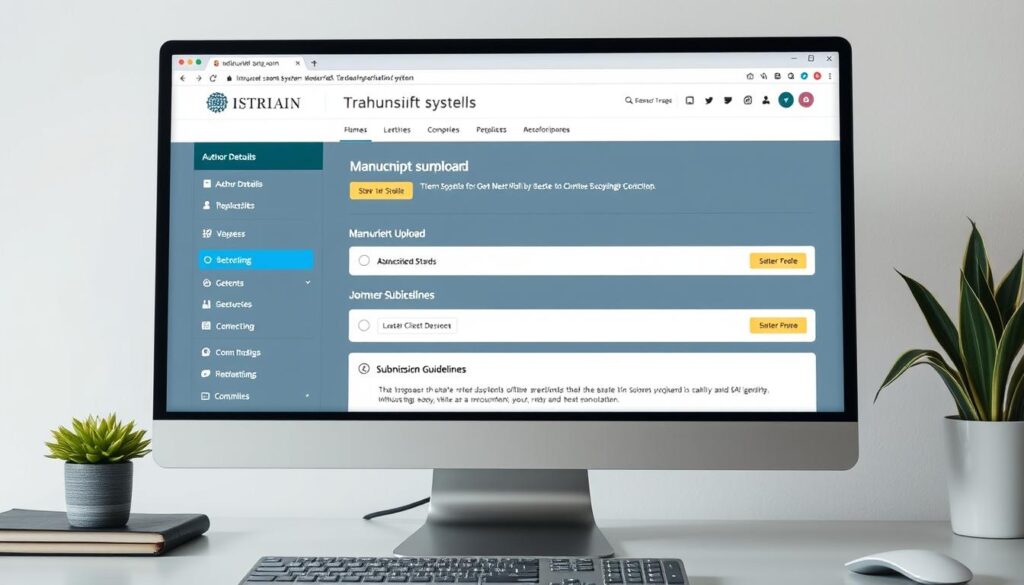Did you know that Elsevier, a leading academic publisher, publishes 470,000 journal articles annually1? This staggering number shows the vast opportunities for researchers to share their work. The submission process has become digital, allowing authors to track their papers online. They receive updates on article views, downloads, and citations in real-time21.
Scientific Reports sets the standard for submission, accepting manuscripts in Word, LaTeX, or PDF. The file size limit is practical at 3 MB3. Taylor & Francis Online’s Authored Works section offers researchers perpetual access to their work. They also receive detailed performance updates at regular intervals2.
The submission landscape combines traditional peer review with modern tracking systems. Authors get expert feedback while keeping track of their submission’s progress.
Key Takeaways
- Digital submission systems streamline the publication process
- Manuscript formatting requirements vary by journal
- Real-time tracking tools monitor submission progress
- Author access to article metrics assists impact measurement
- Multiple file format options support diverse submission needs
- Regular performance updates help track article reach
Understanding the Academic Publishing Landscape
The academic publishing world is key to how research is disseminated through peer-reviewed manuscripts. It’s essential to understand this landscape before embarking on your journal submission journey4.
Types of Academic Journals
The publication process differs across various journal types. Some focus on specific research areas, while others cover broader topics. Authors can opt for large-scale publications or specialized journals that target particular fields54.
Impact Factors and Journal Rankings
Journal rankings are critical for evaluating publication quality. The peer review process involves 2-3 expert reviewers assessing manuscript quality. This system ensures high academic standards across disciplines5.
Open Access vs. Traditional Publishing Models
| Publishing Model | Access Type | Cost Structure |
|---|---|---|
| Traditional | Subscription-based | Reader pays |
| Gold Open Access | Immediate free access | Author pays APC |
| Green Open Access | Self-archived access | No direct costs |
| Diamond Open Access | Immediate free access | No APC |
Open Access publishing offers immediate free access to research, revolutionizing how scholars share their work. Traditional models require subscriptions, whereas Gold Open Access asks authors to pay article processing charges, often covered by research funding5.
“Quality research deserves the right platform. Choose your journal wisely to maximize impact.”
Preparing Your Research Paper for Submission
Manuscript preparation in academic writing requires meticulous attention to detail. The sheer volume of research papers submitted to editors globally is staggering. With a new article published every few seconds in peer-reviewed journals6, the competition is fierce.
Strategic planning is key in the manuscript preparation process. Full research papers usually range from 8-10 pages, including five figures and 25-30 references6. Professional language editing services can complete their work in just 7 business days. They offer a money-back guarantee if journals reject manuscripts due to language errors7.
“Excellence in academic writing stems from meticulous preparation and unwavering attention to detail.”
Digital tools significantly improve the manuscript preparation workflow. Mendeley streamlines paper organization, citation management, and reference handling in the cloud7. The Researcher Academy offers valuable e-learning modules for manuscript preparation guidance7.
| Manuscript Component | Key Considerations | Impact on Acceptance |
|---|---|---|
| Language Quality | Native Speaker Editing | Critical |
| Structure | Journal Guidelines | High |
| References | Digital Management | Moderate |
| Formatting | Journal Standards | Essential |
Before submitting your manuscript, take a brief pause. This allows you to identify necessary changes and improvements in your academic writing8. It’s important to avoid incomplete reporting or selective data presentation, as these practices undermine research integrity8.
Choosing the Right Journal for Your Research
Strategic journal selection is key to research publication success. With about 30,000 scholarly journals, choosing wisely is essential9.
Matching Your Paper to Journal Scope
The research publication process begins with evaluating journal content, aims, and scope. This ensures a good fit9. Leading journals use various metrics to show their academic standing:
| Metric Type | Description | Usage |
|---|---|---|
| CiteScore | Uses Scopus database data | Citation impact measurement |
| SJR | Prestige transfer between journals | Journal ranking system |
| SNIP | Field-specific citation analysis | Subject-normalized impact |
Analyzing Journal Metrics
Impact factors are critical for funding agencies and institutions to assess research quality10. Journal Insights metrics track citations, review times, and global readership over five years11.
“Choose journals that align with your research scope and reach your target audience effectively.”
Considering Publication Timelines
Most journals accept submissions all year, with special themed issues occasionally9. The journal selection process benefits from:
- Consulting colleagues and librarians
- Using journal suggester tools
- Reviewing recent publications
- Evaluating rejection rates
Crafting a Compelling Title and Abstract
Your research paper title is the first thing readers see. Studies indicate that most readers decide to read a paper based on its title and abstract12. It’s essential to keep the title concise, ideally under 16 words, while ensuring clarity and precision13.
A compelling title must strike a balance between providing information and engaging the reader. Leading journals advise against using abbreviations and technical jargon to enhance accessibility12. An analysis of 150,000 papers showed that shorter, descriptive titles receive more citations across various disciplines13.
“The title is your paper’s first impression – make it count.”
When crafting your academic abstract, focus on several key elements:
- Research objective and scope
- Methodology highlights
- Key findings and implications
- Main conclusions
Consider these proven title formats:
| Title Type | Example | Best Used For |
|---|---|---|
| Nominal | Effects of Climate Change on Marine Ecosystems | Descriptive Studies |
| Question | How Does Climate Change Impact Marine Life? | Exploratory Research |
| Declarative | Climate Change Accelerates Marine Ecosystem Decline | Conclusive Studies |
Most academic journals require 3-8 specific keywords that capture your paper’s core themes13. These keywords improve your paper’s discoverability in research databases. They also complement your title and abstract.
Structuring Your Manuscript Effectively
A research paper structure adheres to specific rules and conventions, distinguishing it from casual writing14. The correct arrangement of manuscript sections is critical for publication success in academic journals15.
Introduction and Literature Review
The Introduction section lays out the research problems and background, establishing the study’s foundation14. It’s known that 30-50% of manuscripts are rejected before peer review due to poor structure15.
Methodology and Results
The Methods section outlines the study’s procedures and analytical methods. The Results section presents findings, aligning with the methodology and supported by statistical data14.
Discussion and Conclusion
The manuscript sections should progress from broad to specific and then back to broad, ensuring a logical flow14.
“Quality research writing relies on coherence, organization, relevance, and clarity to engage both expert and non-expert readers.”
| Manuscript Section | Key Components | Writing Order |
|---|---|---|
| Introduction | Research Problem, Background, Objectives | Last |
| Methods | Procedures, Analysis Techniques | First |
| Results | Findings, Statistical Data | Second |
| Discussion | Interpretation, Implications | Third |
Formatting Your Paper According to Journal Guidelines

Starting your manuscript submission journey with the right journal formatting is key. Each academic field has its own formatting style, ensuring consistency and professionalism. For instance, APA format is the norm in Education and Psychology, while MLA is the go-to in Literature and Arts16.
“Precision in manuscript guidelines adherence determines the speed of your paper’s review process.”
Adhering to basic guidelines is critical. Use a 12-point font for body text and up to 16-point for titles17. Ensure one-inch margins on all sides, with page numbers placed half an inch from the upper-right corner16.
| Document Type | Average Length | Display Items |
|---|---|---|
| Physical Sciences Papers | 6 pages (2500 words) | 4 items |
| Biological Sciences Papers | 8 pages (4300 words) | 5-6 items |
In physical sciences, papers usually span 6 pages with 4 display items. Biological and social sciences papers, on the other hand, reach 8 pages with 5-6 display items18. Remember, titles should not exceed 75 characters, including spaces18.
- Double-space all text content
- Center and capitalize section headings
- Left-justify subheadings
- Include page numbers consistently
Each scientific discipline has its own format requirements. It’s vital to grasp general formatting principles to easily adapt to specific journal guidelines17.
Creating Effective Figures and Tables
Research data visualization is key in academic publishing, with 80% of successful journal submissions using visual elements19. Scientific figures, such as graphs and charts, make up over 50% of visual content in research papers19.
Data Visualization Best Practices
Tables organize raw data in rows and columns, while figures like graphs and charts show relationships20. The choice of visualization depends on the data’s structure:
- Tables for detailed categorical data
- Bar charts for comparing quantities
- Line graphs for trends
- Pie charts for proportional relationships
Captions and Legends
Clear labeling boosts reader understanding by 40%, while visuals without captions cause 70% more confusion19. Each visual must be properly attributed to prevent plagiarism21.
| Visual Element | Usage Percentage | Primary Purpose |
|---|---|---|
| Graphs/Charts | 50% | Show relationships and trends |
| Tables | 30% | Present detailed data |
| Other Figures | 20% | Illustrate concepts |
“Effective research data visualization transforms complex information into clear, actionable insights.”
Crafting a Strong Cover Letter
A well-crafted journal cover letter is essential for manuscript submission success. Research indicates that a compelling cover letter greatly influences editors’ decisions to review papers22.
When preparing your manuscript submission, remember these key points:
- Editor’s name and title
- Journal name
- Manuscript title
- Brief methodology overview
- Key findings and conclusions
- Contact information
The cover letter should be concise, no longer than one page. It should avoid unnecessary jargon and exaggerated claims about research significance23. Professional standards require using formal language and addressing editors correctly22.
“Your cover letter serves as your research’s first impression – make it count.”
An effective journal cover letter should emphasize why your research aligns with the journal’s scope and benefits its readers. Include contextual background to explain the research question’s importance and study implications22.
| Cover Letter Components | Best Practices |
|---|---|
| Length | One page maximum |
| Tone | Professional and formal |
| Content Focus | Research relevance and impact |
| Structure | Clear and organized |
Always check the specific journal’s requirements for cover letter content. Different publications have unique Instructions for Authors (IFAs)23. Adhering to these guidelines helps avoid automatic rejection of your manuscript22.
Academic Journals, Publications, List of Publications, Submit, Research Paper
The academic publishing world is constantly changing, with various scholarly outlets playing a key role in research dissemination. Leading publishers, such as MDPI, manage extensive portfolios of peer-reviewed journals. They publish 444 journals and 9 conference-specific publications24.
These outlets cover a wide range of disciplines, from ancient studies to the latest in science. Cambridge University Press is a prime example, with journals in areas like Ancient Mesoamerica, Agricultural Economics, and Antarctic Science25.
“Academic publishing bridges the gap between research and global knowledge sharing, making scholarly work accessible to wider audiences.”
Statistics on research dissemination show significant publication volumes across various fields. “Cancers” leads with 29,731 published articles, while “Applied Sciences” boasts a substantial 67,974 articles24.
| Journal Name | Current Issue Articles | Total Published Articles |
|---|---|---|
| Cancers | 124 | 29,731 |
| Animals | 87 | 18,537 |
| Agriculture | 86 | 9,157 |
- Prioritize journals matching your research focus
- Consider publication frequency and volume
- Check journal indexing and accessibility
The evolution of scholarly outlets includes both traditional and open-access models. Many established journals are adapting to meet modern publishing demands25.
Navigating the Online Submission System
Modern academic publishing heavily relies on digital platforms for online manuscript submission. The process begins with setting up an author account. It involves following systematic steps to ensure successful paper submission.

Creating an Author Account
Setting up an author account requires accurate personal and institutional information. Publishers mandate authors to disclose financial relationships, employment details, and any conflicts of interest when creating their profiles26.
Uploading Manuscript Files
The online manuscript submission process involves uploading various document types in specific formats. Authors must ensure their work hasn’t been published elsewhere or under consideration by other journals26.
- Main manuscript file
- Figures and tables
- Supplementary materials
- Cover letter
- Author agreements
Providing Metadata
Authors need to input detailed metadata during submission. This includes author contributions through CRediT roles and funding source declarations26.
| Submission Component | Requirements | Format |
|---|---|---|
| Manuscript | Double-spaced text | DOC/PDF |
| Figures | High resolution | TIFF/JPEG |
| Supplementary Data | Labeled files | ZIP/RAR |
| Author Agreement | Signed document |
“A well-organized online submission enhances the chances of manuscript acceptance and speeds up the review process.”
Journal websites must maintain transparency about access costs, subscription fees, and publishing charges27. All published content undergoes rigorous peer review to maintain high academic standards27.
Understanding the Peer Review Process
The peer review process is a vital part of scientific publishing, with 82% of researchers seeing it as essential for quality control28. It involves several stages to ensure the research meets high standards of quality and credibility.
Scientific journals usually require at least two independent reviewers for each article. These reviewers use detailed checklists to evaluate the research’s scientific merit, methodology, and clinical relevance2930.
“Peer review serves as the scientific community’s quality control system, ensuring research integrity and advancing knowledge through constructive feedback.”
The review process uses different methods to keep identities hidden. Single-blind reviews hide the reviewer’s identity, while double-blind reviews conceal both the author’s and reviewer’s identities29.
| Review Type | Author Identity | Reviewer Identity | Transparency Level |
|---|---|---|---|
| Single-blind | Known | Hidden | Moderate |
| Double-blind | Hidden | Hidden | High |
| Open Review | Known | Known | Complete |
Many journals now embrace transparency by publishing the names of handling editors. They also offer features like peer review reports with accepted papers28. Authors receive detailed feedback and suggestions for improvement, with most manuscripts needing revisions before acceptance30.
Responding to Reviewer Comments
The peer review process is essential in academic publishing, ensuring quality and credibility in scholarly work31. A detailed manuscript revision heavily depends on constructive feedback from reviewers to improve research papers31.
Addressing Major Revisions
Reviewers scrutinize sampling methods, control experiments, and data analysis for soundness32. They identify major flaws like contradictory statistical evidence, insufficient data, or unclear tables as reasons for rejection32.
| Review Component | Key Focus Areas |
|---|---|
| First Read-through | Research question, originality, writing clarity |
| Second Read-through | Argument construction, language clarity |
| Final Assessment | Evidence support, methodology validation |
Handling Minor Changes
Feedback often highlights factual errors, ambiguous meanings, and proper content reflection in titles and keywords32. Reviewers might note typographical errors, suggest specific changes, or ask for additional content clarification33.
Writing a Response Letter
Response letters to reviewer comments can be lengthy, sometimes over 20 pages31. The submission process for revised manuscripts requires response letters, revised papers, cover letters, and any supplementary materials requested by editors or reviewers31.
“A well-crafted response letter demonstrates respect for the peer review process and strengthens the manuscript’s publication prospects.”
Dealing with Rejection and Resubmission
The journey to publication often involves facing manuscript rejection. JAMA accepts just 11% of major manuscripts from over 7,000 submissions each year. Teaching and Learning in Medicine also has a 10% final acceptance rate34. This data shows that rejection is a common hurdle in academic publishing35.
When resubmitting a paper, it’s important to remember that rejection doesn’t mean the research is flawed. The manuscript might need tweaks to align with journal standards or address missing points35. Given that only 30% of submissions reach peer review at Teaching and Learning in Medicine, thorough preparation is essential34.
Developing a backup plan is key to handling rejection. Experts advise authors to have a list of 20 journals ready before the first submission35. This strategy makes the resubmission process smoother if the first attempt fails. Viewing reviewer feedback as constructive advice can help improve the manuscript.
Success in publishing requires perseverance. Studies indicate that persistence through multiple submissions can lead to publication35. When facing rejection, focus on revising the work based on feedback. Journals often welcome resubmissions of manuscripts that have been improved34.
FAQ
What is the typical publication process for academic journals?
How do I choose the right journal for my research paper?
What makes a strong title and abstract?
How should I structure my manuscript?
What should be included in a cover letter?
How does the peer review process work?
How should I handle reviewer comments?
What should I do if my paper is rejected?
How do I navigate online submission systems?
What’s the difference between open access and traditional publishing models?
Source Links
- Publish with Elsevier: Step by step – https://www.elsevier.com/researcher/author/submit-your-paper
- How to publish your research – Author Services – https://authorservices.taylorandfrancis.com/publishing-your-research/
- Submission guidelines | Scientific Reports – https://www.nature.com/srep/author-instructions/submission-guidelines
- Publishing in Academic Journals: Top Strategies for Researchers – San Francisco Edit – https://www.sfedit.net/publishing-in-academic-journals-top-strategies-for-researchers/
- Publication Models and Process – https://pressbooks.pub/researchlifecycle/chapter/publication-models-and-process/
- How to Write and Publish a Research Paper in 7 Steps – De Gruyter Conversations – https://blog.degruyter.com/how-to-write-a-good-research-paper/
- How to submit a paper for publication in a journal – https://scientific-publishing.webshop.elsevier.com/publication-recognition/how-to-submit-a-paper-for-publication-in-a-journal/
- Author’s Checklist for Preparation of Publications – Research – Washington University in St. Louis – https://research.wustl.edu/authors-checklist-preparation-publications/
- PDF – https://authorservices.taylorandfrancis.com/wp-content/uploads/2021/03/Choosing_a_journal_ebook.pdf
- How to select a journal for your research – https://pmc.ncbi.nlm.nih.gov/articles/PMC10292146/
- How to choose a Journal to submit an article | Elsevier Blog – https://scientific-publishing.webshop.elsevier.com/research-process/how-to-choose-a-journal-to-submit-an-article/
- Writing the title and abstract for a research paper: Being concise, precise, and meticulous is the key – https://pmc.ncbi.nlm.nih.gov/articles/PMC6398294/
- How to Choose a Research Paper Title with Examples – Wordvice – https://blog.wordvice.com/how-to-write-the-perfect-title-for-your-research-paper/
- Writing an Effective Research Paper: Structure & Content – Wordvice – https://blog.wordvice.com/seminar-how-to-write-an-effective-research-paper/
- 7 steps to publishing in a scientific journal – https://www.elsevier.com/connect/7-steps-to-publishing-in-a-scientific-journal
- JotterPad – Write Create Stunning Documents On The Go. – https://jotterpad.app/how-to-format-a-research-paper/
- Microsoft Word – HTW_pdf_title_cover_page_v2014.docx – https://www.bates.edu/biology/files/2010/06/How-to-Write-Guide-v10-2014.pdf
- Formatting guide | Nature – https://www.nature.com/nature/for-authors/formatting-guide
- 3.4 Figures and Tables – https://pressbooks.bccampus.ca/technicalwriting/chapter/figurestables/
- Figures and Charts – The Writing Center • University of North Carolina at Chapel Hill – https://writingcenter.unc.edu/tips-and-tools/figures-and-charts/
- Effective Use of Tables and Figures in Research Papers – Enago Academy – https://www.enago.com/academy/how-to-use-tables-and-figures-to-effectively-organize-data-in-research-papers/
- How to Write a Cover Letter for Journal Submission – Wordvice – https://blog.wordvice.com/journal-submission-cover-letter/
- How to write a cover letter for journal article submission | Author Services – https://authorservices.taylorandfrancis.com/publishing-your-research/making-your-submission/writing-a-journal-article-cover-letter/
- MDPI | MDPI Journal List – https://www.mdpi.com/about/journals
- Journals | Publications | Cambridge Core – https://www.cambridge.org/core/publications/journals
- Guide for authors – Your Paper Your Way – https://www.elsevier.com/subject/next/guide-for-authors
- Subject and Course Guides: Selecting Publication Venues: Where to Publish? – https://researchguides.uic.edu/journalselection
- Reviewers | What is peer review? | Elsevier – https://www.elsevier.com/reviewer/what-is-peer-review
- PUBLISHING YOUR WORK IN A JOURNAL: UNDERSTANDING THE PEER REVIEW PROCESS – https://www.ncbi.nlm.nih.gov/pmc/articles/PMC3474310/
- Understanding peer review – Author Services – https://authorservices.taylorandfrancis.com/publishing-your-research/peer-review/
- How to respond to peer reviewers comments | Researcher blog – https://www.f1000.com/researcher_blog/how-to-respond-to-peer-reviewers-comments/
- Step by Step Guide to Reviewing a Manuscript – https://authorservices.wiley.com/Reviewers/journal-reviewers/how-to-perform-a-peer-review/step-by-step-guide-to-reviewing-a-manuscript.html
- Sample Response to Reviewers – https://apastyle.apa.org/style-grammar-guidelines/research-publication/sample-response-reviewers.pdf
- HSL Library Guides: Getting Published Guide: Part 6 – Dealing with Rejection – https://guides.med.ucf.edu/gettingpublished/publication-rejection
- How to Deal with Rejection from Academic Journals (And Steps to Take before Resubmission) | Scribendi – https://www.scribendi.com/academy/articles/rejection_from_academic_journals.en.html


